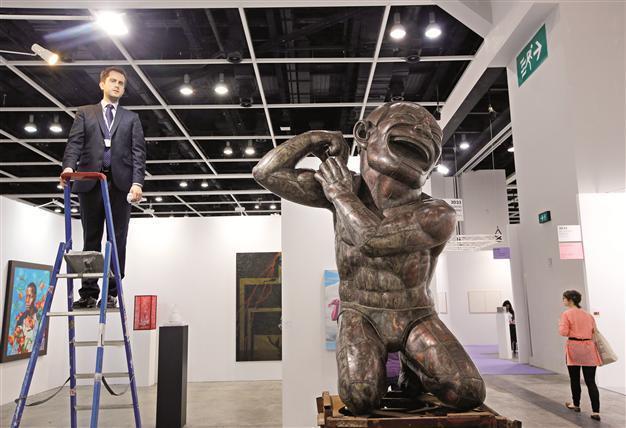Art Basel takes art world by storm
BASEL - Agence France-Presse

Art Basel is not only about investment; it is also about the enjoyment of seeing a wide range of work by the great artists of the 20th century, such as Picasso, Kandinsky and Warhol.
World-renown stars are visiting Art Basel in Switzerland starting from yesterday. This year once again the fair becomes the most important art event. With private jets filling the air and lines of luxury limousines on the ready, deep-pocketed collectors from around the world have flocked to Switzerland this week for Art Basel, the biggest contemporary art fair on the planet.
The 44th edition of the show opens to the public on yesterday, but the doors were nudged open already on June 11 for special VIPs wanting an advance peek at the wide range of artwork displayed across a whopping 31,000 square meters of exhibition space. On June 12, an estimated 110 private jets landed and took off from the Basel-Mulhouse airport, after 83 flew through there on June 11 despite a strike that reduced the airport’s capacity and forced some wealthy patrons of the arts to change their travel plans.
It was important to be among the first to squeeze through the doors, Annka Kultys, a Swiss art collector based in London, told AFP. “The rule in Basel is that you cannot put (artwork) on hold before the art fair, so we need to be here the first day, and just run to the booths that we are interested in,” she said.
“I know exactly where I want to go when I come here, which gallery I want to see, which artist,” she added.
Some 65,000 visitors are expected to come to Art Basel this year to see exhibits by a lucky 304 galleries, picked from more than 1,000 that vied for a spot at the lucrative fair.
“There’s been a buzz immediately,” Tim Marlow, director of exhibitions at the London-based White Cube Gallery told AFP, just a few hours after the buying frenzy began.
“We’ve sold two Sergei Jensen paintings, a Tracey Emin, we sold this Mark Bradford work for $725,000,” he said, pointing to the large abstract canvas behind him.
“And there is serious interest in the Damien Hirst pill cabinet, at four million pounds,” he added with a broad smile, nodding to a large mirror wall lined with tightly spaced, narrow metal shelves covered with pills in different colors and shapes.
Art market, galleries and Art Basel effect
Art Basel’s impact on a gallery’s bottom line does not stop with what is sold at the fair, he said.
“It’s about connections made and clients made, and museums. A lot of museums come... and then conversations are hatched, work is bought... exhibitions are planned.” The art world appears to have bucked the global economic crisis, with income from global auction sales more than doubling since it hit bottom in 2009, passing eight billion euros last year, according to French specialized website Artprice.com.
“I reckon that in the next 10 years we’ll see the market going from about five percent of the world’s rich having art to around 40 percent,” said Philip Hoffman, the head of the Fine Art Fund Group, which advises wealthy clients on what pieces to add to their collections.
But Art Basel is not only about investment; it is also about the enjoyment of seeing a wide range of work by the great artists of the 20th century, such as Picasso, Kandinsky and Warhol, mixed in with the cutting edge of today, Spiegler said.
For those more interested in looking than buying, a whole hall has been reserved for the “Unlimited” collection of large and sometimes astonishing works that are not for sale at the fair. Unlike in the crowded section next door, there is plenty of space to stroll through the 11,500-square-metre exhibit, admiring works by Chinese dissident artist Ai Weiwei, British sculptor Antony Gormley, or Japanese Chiharu Shiota, who has covered chairs and a grand piano in a massive web of black string.
